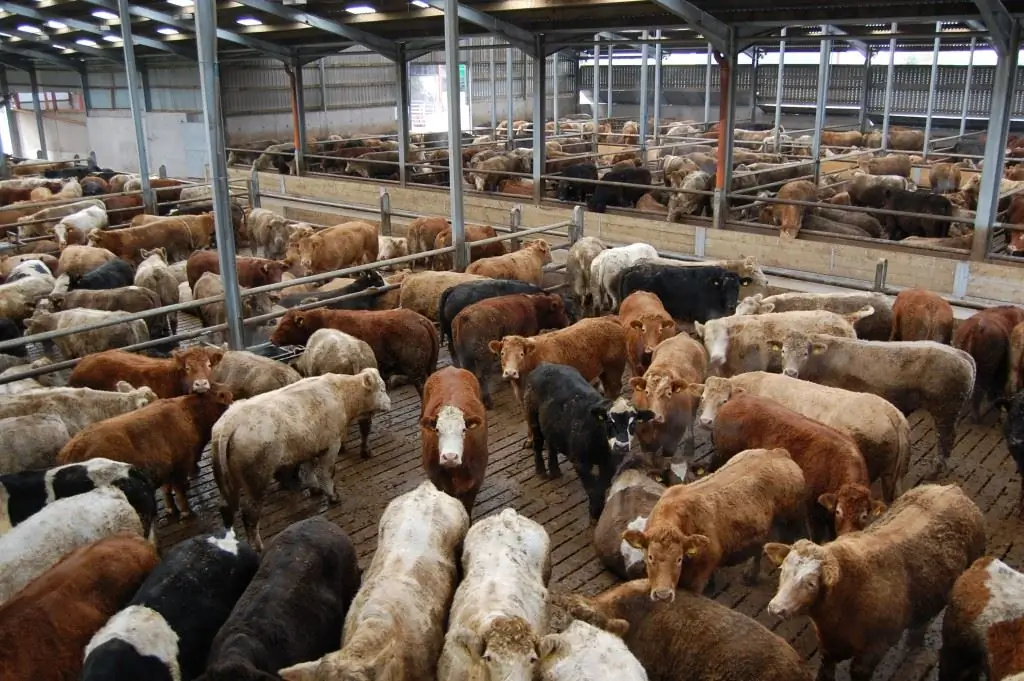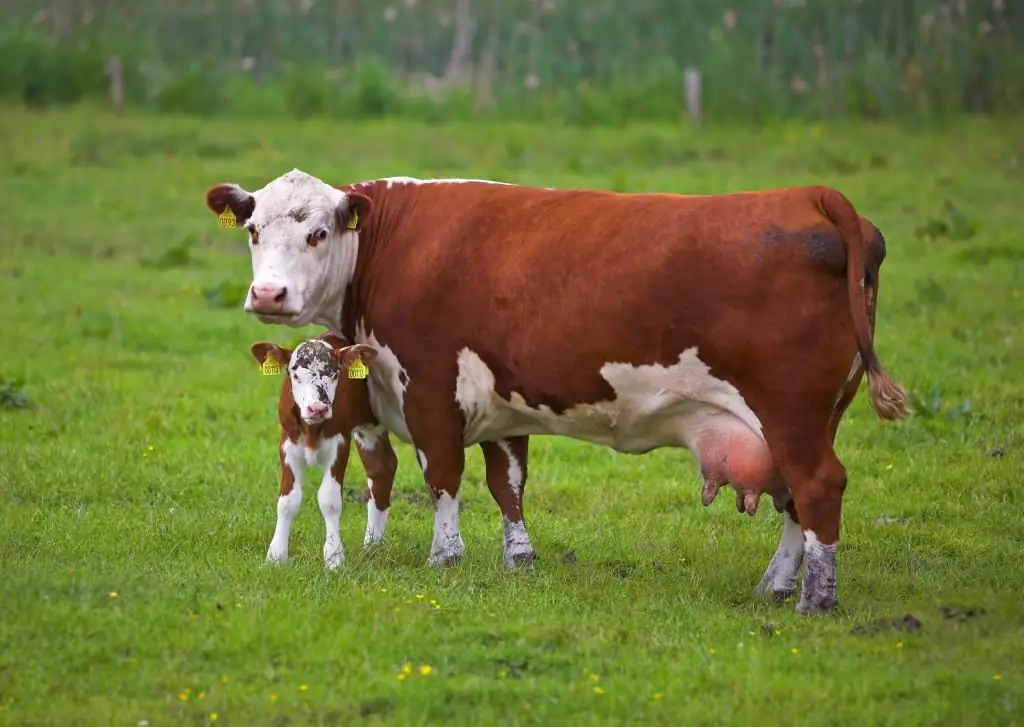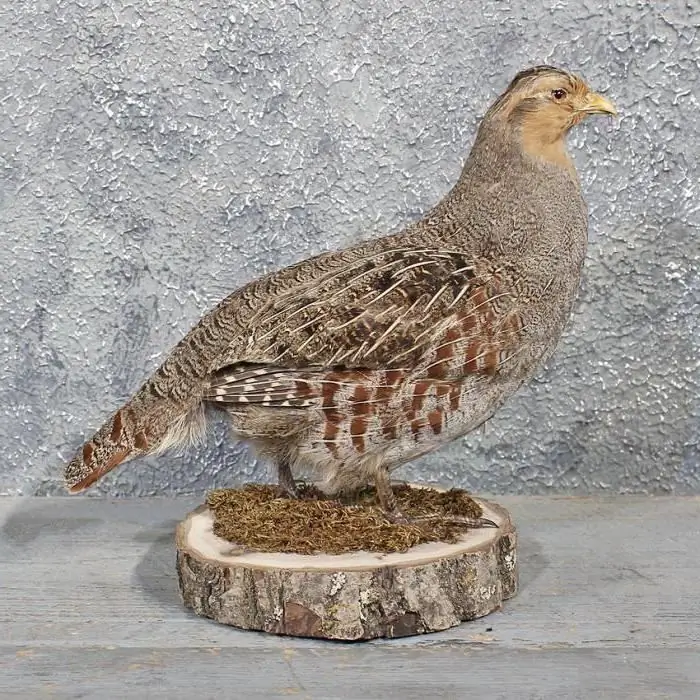2025 Author: Howard Calhoun | [email protected]. Last modified: 2025-01-24 13:10:32
Most modern breeds of cows are known for their endurance, good he alth and good performance. Farms specializing in raising cattle are usually profitable, and their owners receive considerable profits. However, in order for such animals to give a lot of meat and milk, one should, of course, strictly follow the technology of their maintenance. Cattle must first of all receive high-quality feed in sufficient quantities. Cows should be housed in clean, ventilated, warm rooms.
Types of cattle by productivity
All currently existing breeds of cattle are divided into two large groups: meat and dairy. In Russia, traditionally, breeds of cows belonging to the second type of productivity are mainly bred. The vast majority of farms in our country are engaged in the cultivation of dairy cattle. Private owners usually also keep just such cattle.

Dairy cows: the most popular breeds
The profitability of any farm primarily depends, of course, onhow good conditions for keeping cattle on it are provided. However, for farmers who want to maximize the profits from their business, it is equally important, among other things, to choose the right breed of cattle.
At the moment, cows are the most popular and widespread type of productive animals. Cattle are grown in most countries of the world. And, of course, selection work with this type of farm animals is carried out on a very large scale. A lot of good breeds of cows were bred by specialists. This also applies, of course, to cattle in the dairy direction of productivity.
In Russia and the countries of the former CIS, the most popular breeds of cows in this group are:
- Holstein;
- Dutch;
- black-and-white;
- red steppe;
- Kholmogory;
- Yaroslavskaya.
The Holstein is considered the most productive breed from this list. From one such cow for a milking period, you can get up to 7-10 tons of milk. The disadvantage of cattle of this breed is considered to be only some capriciousness in terms of conditions of detention. For Holstein cows, farmers have to select, for example, the highest quality food.

The last four domestic breeds are considered the most undemanding breeds from the list above. Such cows give less milk than Dutch and Holstein ones. Annual milk yields from them range from 4.5-7 tons. But the costs of keeping cattle of these varieties are usually nottoo big.
Popular meat breeds
Some farmers in our country also keep such livestock. Cows of this productivity group are grown for meat. Calves are not separated from their mother when breeding cattle of this type at an early age.
The most popular breeds of beef cows in Russia are:
- Kazakh white-headed;
- Hereford;
- Kalmyk.
The content of Kazakh white-headed cattle is already beneficial because bulls of this breed are able to gain weight up to 1 ton, and cows - 600 kg. The slaughter age of such cattle reaches 1.5 years. Adult bulls and Hereford cows weigh about the same. The advantage of this breed is very tasty marbled meat, the minus is low milk content. Hereford calves, unfortunately, have to be fed almost from the first days of their birth.
Kalmyk bulls are also capable of gaining body weight up to 1 ton. Cows of this breed weigh about 550 kg. Kalmyk cattle also show good performance in terms of milk yield - 1-1.2 tons per year. In addition, the milk of such cows is usually very fatty. And this, in turn, of course, has the most beneficial effect on the he alth of calves and their ability to quickly gain weight.
Main content technologies
For successful breeding of cattle in any direction of productivity, it is important to provide animals with:
- good living conditions by building a spacious barn;
- complete nutrition by developing the most suitable diet for this breed.
Main breeding technologiesthere are only two cattle:
- tethered;
- loose.
At the same time, the following methods of keeping cattle can be used on the farm:
- stall;
- pasture.
All of these methods are now widely used on farms in Russia.

Tethered content
Such a system is organized most often in large livestock complexes. At the same time, tethered technology is used only when keeping cows of the dairy direction of productivity. In Russia, more than 90% of farms specializing in cattle breeding work according to this principle.
Cows using this technology are kept on a leash in small pens. All technological operations in such a farm, including feeding and milking, are carried out in a limited area. The diet of cattle in a stall is made up mainly of concentrated feed and impurities.
The main disadvantage of this method of breeding cows is, first of all, that the animals in this case are deprived of the opportunity to actively move. Because of this, even if all the norms laid down in terms of feeding and care are observed, keeping cattle on the farm becomes less profitable. Animals in such farms reduce productivity and often get sick. Consequently, farmers have a need for additional costs for veterinary services.

Features of organizing a farm with a tetheredcontents
Place cows in such farms in paddocks, in most cases having a length of 2 meters. This distance is quite enough for the manure to be collected in a special chute and discharged outside the barn. Feeders and drinkers are mounted in front of the corrals on farms of this variety.
Stalls are located in farms using the technology of tethered keeping of cattle, in 2-4 rows. Next to the room where the cows themselves are placed, in such complexes there are rooms for cooling milk and servicing the equipment used. Milking on such farms is carried out using a special complex automated system. In small farms, mobile devices can also be used for this purpose. On very small farms, tethered milking is often done by hand.
Tetherless Method
This technology of keeping cattle was originally used only for beef cattle. However, recently this technique is increasingly being introduced on farms specializing in the cultivation of dairy cattle. This is due primarily to the emergence of new modern equipment that allows organizing milking parlors in such barns.
When using the method of loose keeping of cattle, animals have the opportunity to walk around the entire area of the complex. Cramped stalls on such farms are not equipped. As a result, cows get sick less and their productivity increases.
Loose content features
Cows on farms organized in this way usuallydivided into technological groups (by age, productivity, etc.) of 25-50 heads. The distribution of feed for animals in such complexes is carried out using loaders. Also, on farms with free-range keeping of cattle, automated individual feeding stations are organized, designed for a certain group of cows. Manure in complexes of this type is removed using bulldozers.

The composition of feed on farms when keeping cows loosely is selected for each group of animals separately. This allows you to effectively control the amount of vitamins, trace elements and nutrients received by cattle.
Cow stalls
When using this technology, the cattle bred on the farm does not leave its territory throughout its life. The stall method of keeping cows is used, usually in areas where arable land prevails and there are no pastures located near water bodies.
The disadvantages of this cattle breeding technology include, first of all, the fact that cows do not have the opportunity to eat fresh green grass even in the summer. As a result, the farm's feed costs are skyrocketing.
On top of everything else, the animals on these farms are under constant stress. Also, they often manifest various kinds of diseases of the musculoskeletal system. These problems are especially common when using tethered containment technology.
The main advantage of stall breeding of cattle is the possibilityautomation of milking processes, feed distribution, etc. On the farm, using this method, you can place all engineering communications as compactly as possible.
There are only two main varieties of this technology for keeping cattle:
- year-round stall;
- stall-walking.
In the latter case, spacious areas are set up next to the cowshed. Animals are taken here for walks from time to time.
Cattle grazing system
This method of breeding cattle is currently considered the most economically viable in Russia. Using this technology, farms can significantly reduce feed costs.
On the farms of such an organization, in the warm season, cows are driven out to pastures. Animals get the opportunity to actively move and eat the most natural food for them - green grass. It is the cows kept in summer according to pasture technology, and in winter - according to loose technology, that show the best results in terms of productivity. Also, cattle in this case get sick much less.
The advantages of grazing, among other things, include the fact that cows use it to improve the quality of milk. Consequently, farmers are able to sell it at a higher price. Some food processors even pay farmers a special bonus for pasture milk.
The disadvantages of this technology of keeping on grazing include mainly only the difficulty of monitoring the herd. sick animals orInjured in this case, it is difficult to identify immediately.

Rules for keeping cattle: feeding features
The diet for both dairy and beef cows should be as balanced as possible. Animals in both of these productivity groups should receive sufficient amounts of proteins, vitamins, minerals, etc.
All feeds used in animal husbandry are classified into three large groups:
- juicy - vegetables, root vegetables, silos;
- coarse - grass, hay, straw;
- concentrated - grain, bran, compound feed.
In the diet of cattle of both productivity groups, all these varieties must be present without fail.
Peculiarities of feeding dairy cattle
The diet of cows in this direction of productivity must necessarily include cereals and legumes, root crops, silage, cake. In winter, only the highest quality hay should be used for such animals. The advantage of using such feeds is, first of all, an increase in the palatability of milk.
To ensure high milk yields on the farm with cattle, cows should be provided with a sufficient amount of concentrates. However, too many of these feeds are usually not introduced into the diet of dairy cows. Otherwise, the animals will give milk with reduced fat content (due to reduced formation of acetic acid in the rumen).
Feeding beef cattle
On farms specializing in the breeding of such cattle, special attention should be paid to the development of the dietbroodstock. Cows-producers should eat as balanced as possible. In this case, the herd will be replenished with he althy, resilient calves capable of rapid development.
Young meat breeds are fed, of course, with the most nutritious food. In the first six months of life, milk or skim milk must be present in the diet of such calves. Starting from 6 months, food waste is introduced into the menu of meat cattle, among other things.

In summer, it is desirable to drive such bulls and heifers to pastures rich in cereals, legumes and meadow grasses. Also, in the warm season, meat cattle are often given dried corn stalks, alfalfa and clover. In winter, in addition to concentrates, silage and straw are necessarily introduced into the diet of such cows.
Recommended:
Slaughter of cattle at meat processing plants: rules, technology, methods and methods

Providing the consumer basket with meat products directly depends on the slaughter and processing of cattle. Delicious beef and veal dishes are largely the merit of livestock breeders who know how to properly slaughter bulls and cows. There are various technologies, methods and methods for slaughtering cattle, which make it possible to obtain high quality meat products
Cow: keeping at home, methods and technologies

Cows are kept in two ways: tethered and loose. In the household, the loose method is the most popular, giving the animal a certain freedom of movement, which has a positive effect on the he alth of the cow and the milk received from it
Raising a calf: methods, tips for breeding and keeping. Diet of calves, characteristics and features of breeds

Now more and more people leave the big cities and go to the outback. The settlers want to engage in agriculture, but they still do not know how to do much. For example, it is not uncommon when a cow gave birth, and the owner does not know what to do with the offspring. Calves are raised by different methods, but in order to choose the best method for yourself, it is better to familiarize yourself with all existing
Cattle piroplasmosis: etiology, causes and signs, symptoms and treatment of cattle

Most often, outbreaks of piroplasmosis are recorded in the spring-autumn season. Cows go out to pastures where they encounter infected ticks. The disease is transmitted through the bite of a parasite and can cause a decrease in herd productivity. In some cases, the death of livestock occurs. To prevent economic losses, it is necessary to carry out preventive measures
Partridges: breeding and keeping at home. Breeding and keeping partridges at home as a business

Breeding partridges at home as a business is a wonderful idea, because so far it is exotic to some extent, does not require significant investments at the start (or even none at all), there is no special knowledge for growing an unpretentious and little sick bird need. And demand today exceeds supply. This business can be especially interesting in small towns and villages where there are problems with employment and other types of earnings

